Enhancing Gluten-Free Crispy Waffles with Soybean Residue (Okara) Flour: Rheological, Nutritional, and Sensory Impacts
Abstract
:1. Introduction
2. Materials and Methods
2.1. Materials
2.2. Preparation of Waffles
2.3. Rheological Analysis of Waffle Batter
2.3.1. Sample Preparation
2.3.2. Oscillatory Measurements
2.3.3. Transient Measurements
2.4. Physical and Textural Properties of Crispy Waffles
2.4.1. Spread Ratio Analysis
2.4.2. Water Activity (aw) and Moisture Content
2.4.3. Surface Color
2.4.4. Proximate Composition and Nutritional Value
2.4.5. Texture Analysis
2.5. Functional Properties of Okara Flour and Crispy Waffles
2.5.1. Sample Preparation
2.5.2. Cholesterol Adsorption Capacity (CAC)
2.5.3. Glucose Adsorption Capacity (GAC)
2.6. Sensory Evaluation and Consumer Study of Crispy Waffles
2.7. Storage Stability of Crispy Waffle
2.8. Statistical Analysis
3. Results
3.1. Viscoelastic Properties of Waffle Batters
3.2. Physical Properties and Proximate Composition of Crispy Waffles
3.2.1. Spread Ratio, Moisture Content, Water Activity, and Surface Color
3.2.2. Nutritional Composition
3.3. Cholesterol and Glucose Adsorption Capacities
3.4. Storage Stability
3.5. Sensory Evaluation and Consumer Study
3.5.1. Affective Test
3.5.2. Check-All-That-Apply (CATA) Analysis
- Cochran’s Q Test
- Correspondence Analysis (CA)
- Penalty-lift Analysis
- Principal Coordinate Analysis (PCoA)
4. Discussion
- Impact of Okara Flour Content:
- Effect of Particle Size:
- Viscoelastic Properties:
- Creep–Recovery Behavior:
- Physical Properties and Proximate Composition of Crispy Waffles:
- Cholesterol and Glucose Adsorption Capacities:
- Storage Stability:
- Sensory Evaluation and Consumer Study:
- Impact of Okara Flour on Sensory Attributes
- Enhancing Texture in Okara-Based Crispy Snacks
- Preference Mapping and Sensory Optimization
- Ingredient Combinations and Quality Enhancement
- Future Research Directions:
5. Conclusions
Author Contributions
Funding
Institutional Review Board Statement
Informed Consent Statement
Data Availability Statement
Acknowledgments
Conflicts of Interest
References
- Kamble, D.B.; Rani, S. Bioactive components, in vitro digestibility, microstructure and application of soybean residue (okara): A review. Legume Sci. 2020, 2, e32. [Google Scholar] [CrossRef]
- Office of Agricultural Economics, Ministry of Agriculture and Cooperatives. Soybean Production and Demand Statistics. 2024. Available online: https://www.oae.go.th/ (accessed on 10 June 2024).
- Davy, P.; Vuong, Q.V. Soy Milk By-product: Its Composition and Utilisation. Food Rev. Int. 2022, 38 (Suppl. S1), 147–169. [Google Scholar] [CrossRef]
- Aussanasuwannakul, A.; Treesuwan, W.; Butsuwan, P.; Puntaburt, K.; Teangpook, C. Okara Waste Reduction from Community and Industry by Recycling into High-Value Flour Used as Food Ingredient; National Research Council of Thailand: Bangkok, Thailand, 2022; p. 189. [Google Scholar]
- Ginting, E.; Elisabeth, D.A.A.; Khamidah, A.; Rinaldi, J.; Ambarsari, I.; Antarlina, S.S. The nutritional and economic potential of tofu dreg (okara) and its utilization for high protein food products in Indonesia. J. Agric. Food Res. 2024, 16, 101175. [Google Scholar] [CrossRef]
- Aussanasuwannakul, A.; Teangpook, C.; Treesuwan, W.; Puntaburt, K.; Butsuwan, P. Effect of the Addition of Soybean Residue (Okara) on the Physicochemical, Tribological, Instrumental, and Sensory Texture Properties of Extruded Snacks. Foods 2022, 11, 2967. [Google Scholar] [CrossRef] [PubMed]
- Aussanasuwannakul, A.; Boonbumrung, S.; Pantoa, T. Valorization of Soybean Residue (Okara) by Supercritical Carbon Dioxide Extraction: Compositional, Physicochemical, and Functional Properties of Oil and Defatted Powder. Foods 2023, 12, 2698. [Google Scholar] [CrossRef] [PubMed]
- Pešić, M.B.; Pešić, M.M.; Bezbradica, J.; Stanojević, A.B.; Ivković, P.; Milinčić, D.D.; Demin, M.; Kostić, A.; Dojčinović, B.; Stanojević, S.P. Okara-Enriched Gluten-Free Bread: Nutritional, Antioxidant and Sensory Properties. Molecules 2023, 28, 4098. [Google Scholar] [CrossRef]
- Fatmawati, S.; Nur’aini, V.; Karyantina, M. Ice Cream Cone Formulations from Wheat Flour and Tofu Dregs Flour Added with Beetroot (Beta vulgaris L.). Extract. Agric 2023, 35, 85–98. [Google Scholar] [CrossRef]
- Aussanasuwannakul, A.; Pondicherry, K.; Saengprakai, J. Rheological and tribological characterization of herbal sweet sauce with different stabilizing systems. CyTA J. Food 2022, 20, 158–171. [Google Scholar] [CrossRef]
- Mezger, T.G. The Rheology Handbook, 4th ed.; Vincentz Network: Hanover, Germany, 2014; p. 432. [Google Scholar]
- American_Association_of_Cereal_Chemists_International. Approved Methods of Analysis; Method 10-50.05; Cereals & Grains Association: St. Paul, MN, USA, 2010. [Google Scholar]
- McCleary, B.V. Measurement of Dietary Fiber: Which AOAC Official Method of Analysis to Use. J. AOAC Int. 2023, 106, 917–930. [Google Scholar] [CrossRef]
- Ge, Q.; Mao, J.-W.; Cai, C.; Huang, J.; Zhou, Y.; Fang, J.; Sun, Y.; Sha, R. Effects of twin-screw extrusion on physicochemical properties and functional properties of bamboo shoots dietary fiber. J. Biobased Mater. Bioenergy 2017, 11, 385–390. [Google Scholar] [CrossRef]
- Aussanasuwannakul, A.; Butsuwan, P. Evaluating Microbiological Safety, Sensory Quality, and Packaging for Online Market Success of Roasted Pickled Fish Powder. Foods 2024, 13, 861. [Google Scholar] [CrossRef] [PubMed]
- Oliveira, I.; Marinho, B.; Szymanowska, U.; Karas, M.; Vilela, A. Chemical and Sensory Properties of Waffles Supplemented with Almond Skins. Molecules 2023, 28, 5674. [Google Scholar] [CrossRef]
- Tridtitanakiat, P.C.; Hernández-Estrada, Z.J.; Rayas-Duarte, P. Modeling the Influence of Okara Flour Supplementation from Time-Temperature Drying Treatment on the Quality of Gluten-Free Roll Produced from Rice Flour. Foods 2023, 12, 3421. [Google Scholar] [CrossRef] [PubMed]
- Agu, H.O.; Ihionu, J.C.; Mba, J.C. Sensory and physicochemical properties of biscuit produced from blends of whole wheat, soy okara and tigernut residue flours. Heliyon 2023, 9, e15318. [Google Scholar] [CrossRef]
- Department_of_Medical_Sciences. Microbiological Quality Criteria for Food and Food Contact Containers; Department of Medical Sciences: Nonthaburi, Thailand, 2017. [Google Scholar]
- Lumivero XLSTAT. Statistical and Data Analysis Solution; QSR International: Burlington, MA, USA, 2024. [Google Scholar]
- Brites, L.T.G.F.; Schmiele, M.; Steel, C.J. Chapter 13—Gluten-Free Bakery and Pasta Products. In Alternative and Replacement Foods; Holban, A.M., Grumezescu, A.M., Eds.; Academic Press: Cambridge, MA, USA, 2018; pp. 385–410. [Google Scholar] [CrossRef]
- Demirkesen, I.; Ozkaya, B. Recent strategies for tackling the problems in gluten-free diet and products. Crit. Rev. Food Sci. Nutr. 2022, 62, 571–597. [Google Scholar] [CrossRef]
- Egea, M.B.; De Sousa, T.L.; Dos Santos, D.C.; De Oliveira Filho, J.G.; Guimarães, R.M.; Yoshiara, L.Y.; Lemes, A.C. Application of Soy, Corn, and Bean By-products in the Gluten-free Baking Process: A Review. Food Bioprocess Technol. 2023, 16, 1429–1450. [Google Scholar] [CrossRef]
- Guimarães, R.M.; Pimentel, T.C.; de Rezende, T.A.M.; Silva, J.d.S.; Falcão, H.G.; Ida, E.I.; Egea, M.B. Gluten-free bread: Effect of soy and corn co-products on the quality parameters. Eur. Food Res. Technol. 2019, 245, 1365–1376. [Google Scholar] [CrossRef]
- Park, J.; Choi, I.; Kim, Y. Cookies formulated from fresh okara using starch, soy flour and hydroxypropyl methylcellulose have high quality and nutritional value. LWT Food Sci. Technol. 2015, 63, 660–666. [Google Scholar] [CrossRef]
- Aussanasuwannakul, A.; Puntaburt, K.; Treesuwan, W. Rheological, tribological, and sensory analysis of coconut-oil-modified coconut milk kefir. Curr. Res. Nutr. Food Sci. 2020, 8, 496–503. [Google Scholar] [CrossRef]
- Olakanmi, S.J.; Jayas, D.S.; Paliwal, J. Implications of Blending Pulse and Wheat Flours on Rheology and Quality Characteristics of Baked Goods: A Review. Foods 2022, 11, 3287. [Google Scholar] [CrossRef]
- Cappelli, A.; Oliva, N.; Cini, E. A Systematic Review of Gluten-Free Dough and Bread: Dough Rheology, Bread Characteristics, and Improvement Strategies. Appl. Sci. 2020, 10, 6559. [Google Scholar] [CrossRef]
- Asghar, A.; Afzaal, M.; Saeed, F.; Ahmed, A.; Ateeq, H.; Shah, Y.A.; Islam, F.; Hussain, M.; Akram, N.; Shah, M.A. Valorization and food applications of okara (soybean residue): A concurrent review. Food Sci. Nutr. 2023, 11, 3631–3640. [Google Scholar] [CrossRef] [PubMed]
- Chen, B.; Cai, Y.; Zhao, X.; Wang, S.; Zhuang, Y.; Zhao, Q.; Zhao, M.; Van der Meeren, P. A novel set-type yogurt with improved rheological and sensory properties by the sole addition of insoluble soybean fiber. Food Biosci. 2024, 58, 103739. [Google Scholar] [CrossRef]
- Feng, X.; Chen, H.; Liang, Y.; Geng, M.; He, M.; Huang, Y.; Li, Y.; Teng, F. Effects of electron beam irradiation treatment on the structural and functional properties of okara insoluble dietary fiber. J. Sci. Food Agric. 2023, 103, 195–204. [Google Scholar] [CrossRef]
- Lyu, B.; Wang, H.; Swallah, M.S.; Fu, H.; Shen, Y.; Guo, Z.; Tong, X.; Li, Y.; Yu, H.; Jiang, L. Structure, properties and potential bioactivities of high-purity insoluble fibre from soybean dregs (Okara). Food Chem. 2021, 364, 130402. [Google Scholar] [CrossRef]
- Liang, Z.; Li, K.; Huang, W.; Li, Z.; Xu, X.; Xu, H.; Li, S. Production, structural and functional characteristics of soluble dietary fiber from fermented okara by Penicillium expansum. Int. J. Biol. Macromol. 2023, 253, 126621. [Google Scholar] [CrossRef]
- Tian, Y.; Wu, T.; Sheng, Y.; Li, L.; Wang, C. Effects of cavitation-jet technology combined with enzyme treatment on the structure properties and functional properties of OKARA insoluble dietary fiber. Food Chem. 2023, 423, 136286. [Google Scholar] [CrossRef]
- Zhang, G.; Hao, M.; He, Y.; Ahmad, I.; Ding, Y.; Lyu, F. Structural, physicochemical, and functional properties of insoluble dietary fiber derived from okara by Viscozyme®L. J. Food Sci. 2023, 88, 1994–2008. [Google Scholar] [CrossRef] [PubMed]
- Ma, Z.-Q.; Zhang, N.; Zhai, X.-T.; Tan, B. Structural, physicochemical and functional properties of dietary fiber from brown rice products treated by different processing techniques. LWT 2023, 182, 114789. [Google Scholar] [CrossRef]
- Hu, K.; Chen, D.; Sun, Z. Structures, physicochemical properties, and hypoglycemic activities of soluble dietary fibers from white and black glutinous rice bran: A comparative study. Food Res. Int. 2022, 159, 111423. [Google Scholar] [CrossRef]
- Kreger, J.W.; Lee, Y.; Lee, S.-Y. Perceptual Changes and Drivers of Liking in High Protein Extruded Snacks. J. Food Sci. 2012, 77, S161–S169. [Google Scholar] [CrossRef] [PubMed]
- Lee, D.P.S.; Gan, A.X.; Kim, J.E. Incorporation of biovalorised okara in biscuits: Improvements of nutritional, antioxidant, physical, and sensory properties. LWT 2020, 134, 109902. [Google Scholar] [CrossRef]
- Liu, Y.; Yi, S.; Ye, T.; Leng, Y.; Alomgir Hossen, M.; Sameen, D.E.; Dai, J.; Li, S.; Qin, W. Effects of ultrasonic treatment and homogenization on physicochemical properties of okara dietary fibers for 3D printing cookies. Ultrason. Sonochemistry 2021, 77, 105693. [Google Scholar] [CrossRef] [PubMed]
- Zhao, R.; Zhao, R.; Li, Q.; Li, K.; Liu, Q.; Liu, W.; Hu, H. Improvement effect of different protein powder on cooking characteristics of gluten-free pasta and the establishment of quality evaluation based on principal component analysis. Int. J. Food Sci. Technol. 2024, 59, 1138–1149. [Google Scholar] [CrossRef]

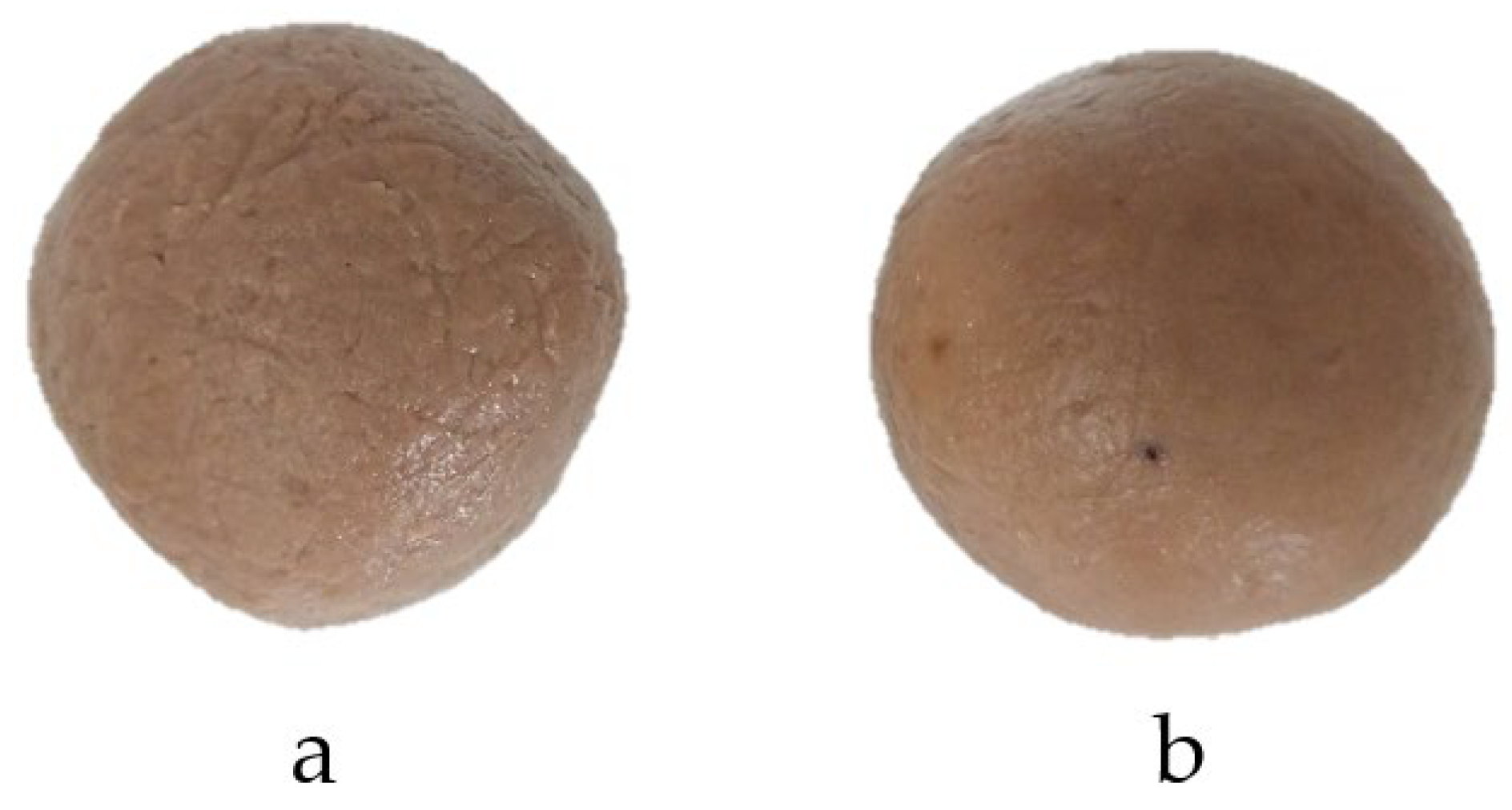
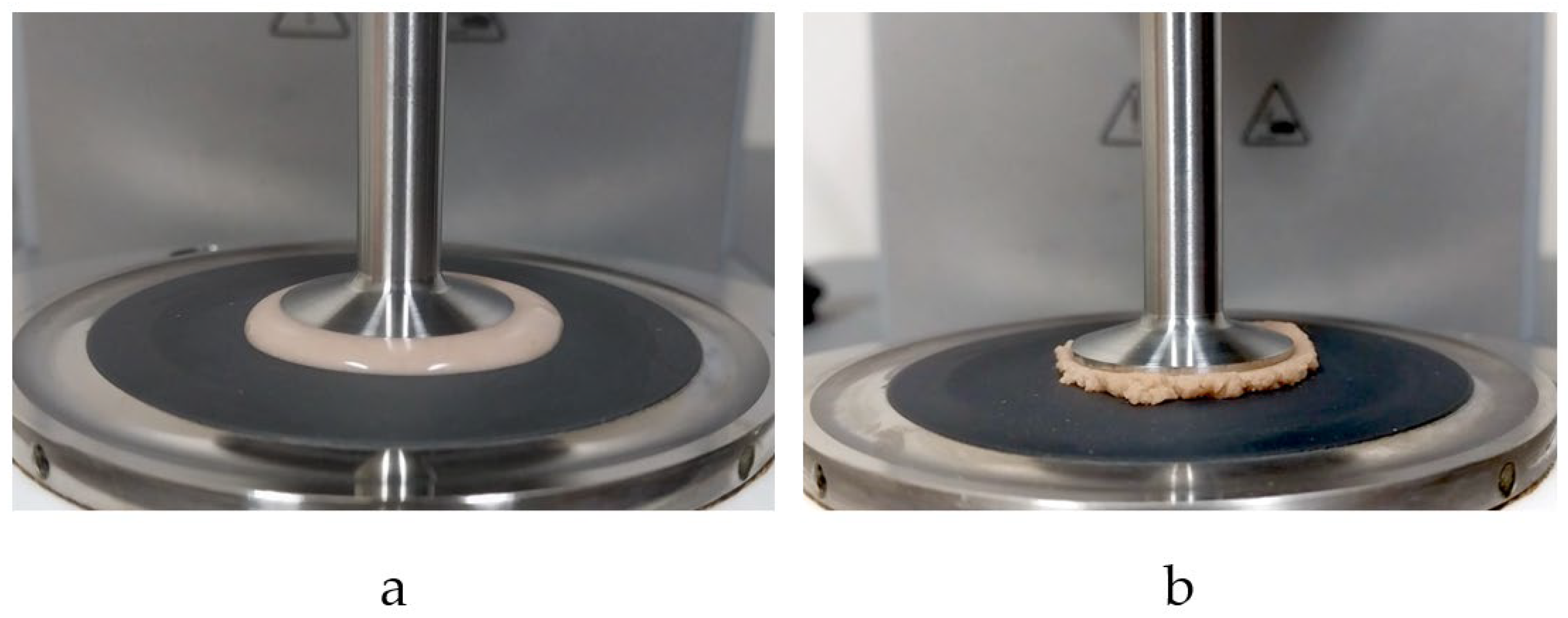
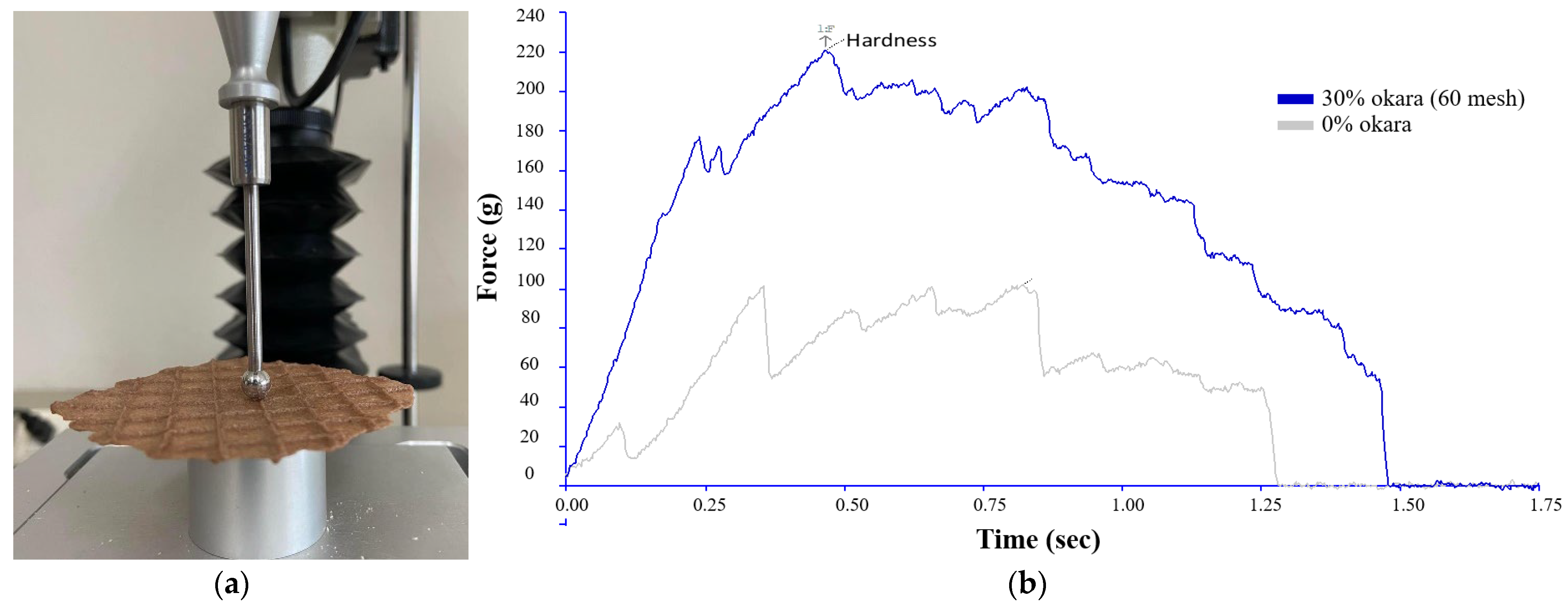


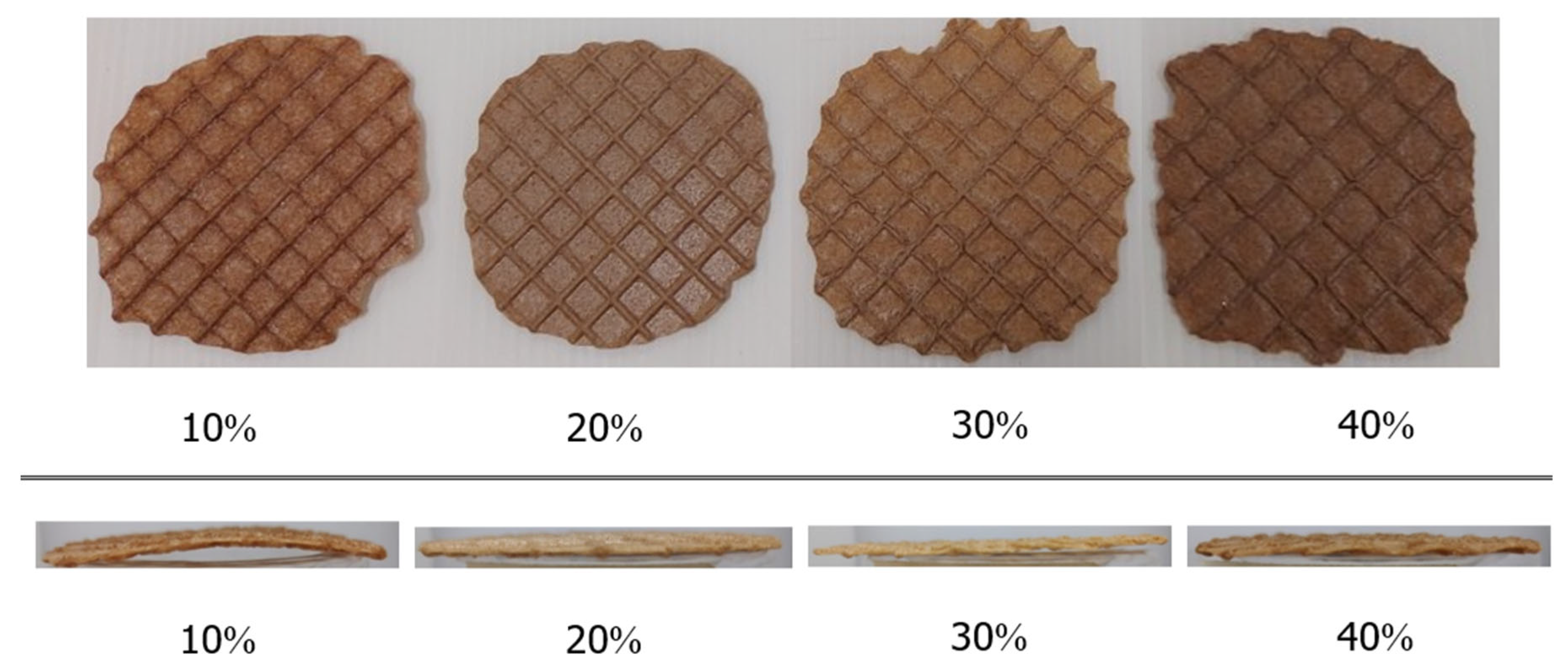

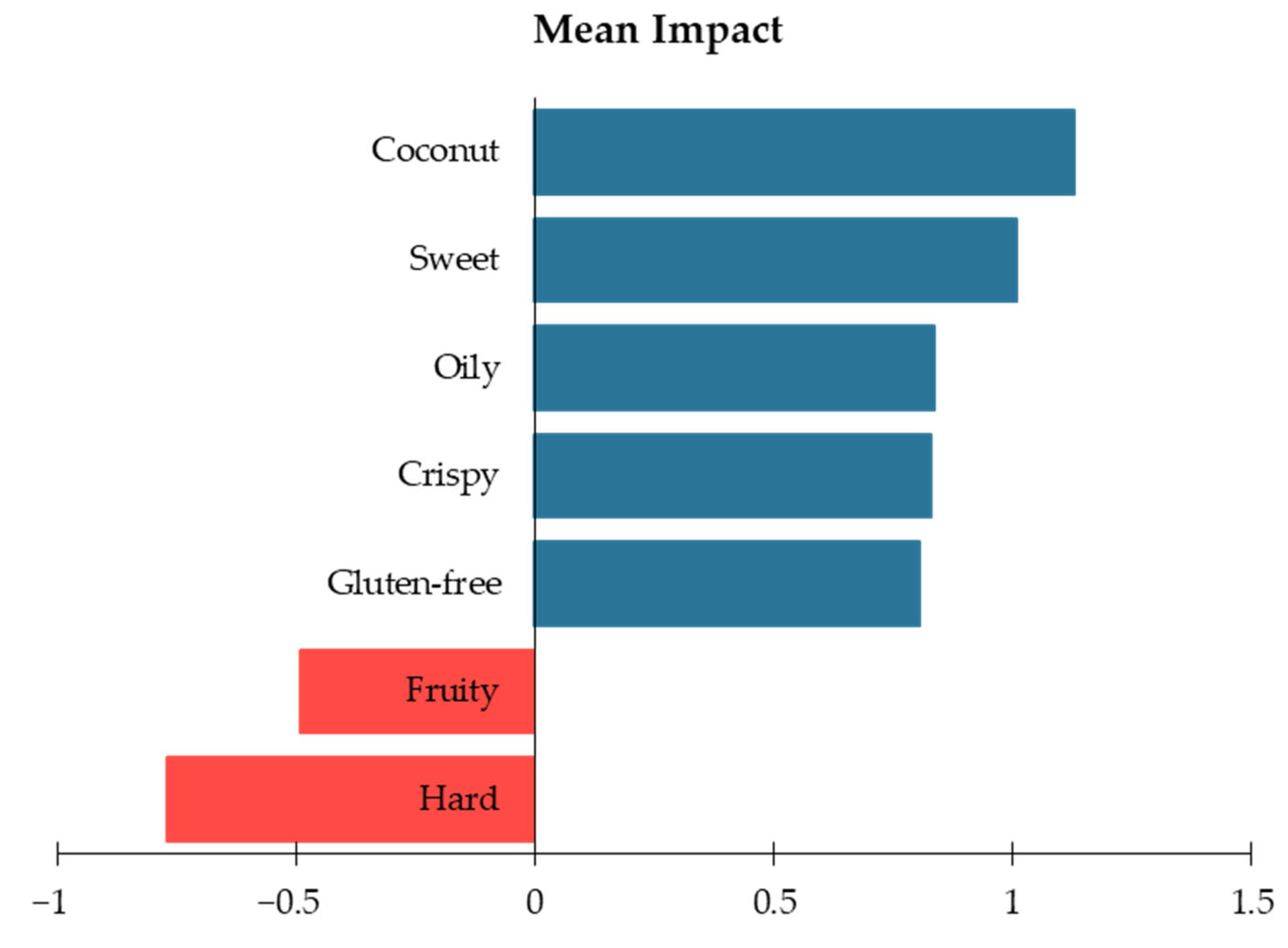
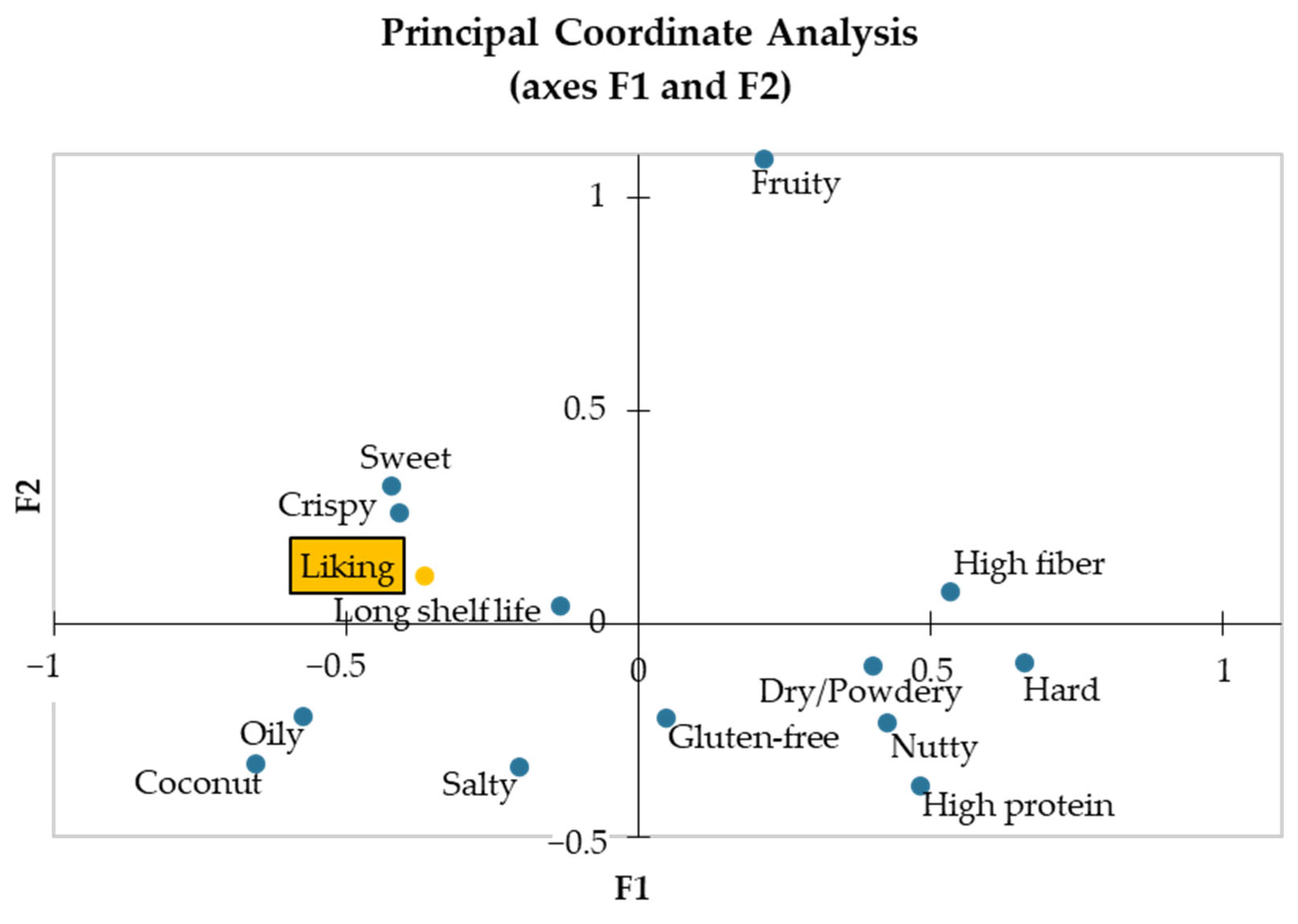
| Ingredients | Okara Flour (%) | ||||
|---|---|---|---|---|---|
| 0 | 10 | 20 | 30 | 40 | |
| Okara flour (g) | 0.0 | 3.5 | 7.0 | 10.5 | 14.0 |
| Glutinous rice flour (g) | 35.0 | 31.5 | 28.0 | 24.5 | 21.0 |
| Tapioca flour (g) | 4.0 | 4.0 | 4.0 | 4.0 | 4.0 |
| Coconut milk (g) | 53.0 | 53.0 | 53.0 | 53.0 | 53.0 |
| Cocoa powder (g) | 1.0 | 1.0 | 1.0 | 1.0 | 1.0 |
| Bakery sugar (g) | 6.1 | 6.1 | 6.1 | 6.1 | 6.1 |
| Salt (g) | 0.8 | 0.8 | 0.8 | 0.8 | 0.8 |
| Baking powder (g) | 0.1 | 0.1 | 0.1 | 0.1 | 0.1 |
| Okara Flour Replacement/Particle Size | |||||
|---|---|---|---|---|---|
| Analyses | Parameters | 0% 60 Mesh | 30% 60 Mesh | 40% 60 Mesh | 40% 80 Mesh |
| Amplitude sweep | Limit LVR (%) | 0.02 ± 0.01 a | 0.06 ± 0.00 b | 0.07 ± 0.00 c | 0.09 ± 0.00 d |
| Flow point (%) | 20.34 ± 1.37 c | 2.17 ± 0.3 a | 3.76 ± 0.07 ab | 4.70 ± 0.02 b | |
| Frequency sweep | (at 10 rad/s) | 0.45 ± 0.06 b | 0.21 ± 0.00 a | 0.19 ± 0.00 a | 0.18 ± 0.00 a |
| (at 10 rad/s; Pa·s) | 3.94 ± 0.93 a | 5862 ± 273 b | 5539.30 ± 243 b | 10,923.33 ± 263 c | |
| Creep and recovery | (%) | - | 0.06 ± 0.02 | 0.05 ± 0.02 | 0.05 ± 0.01 |
| (%) | - | 0.12 ± 0.04 | 0.09 ± 0.04 | 0.05 ± 0.02 | |
| (%) | - | 0.19 ± 0.03 b | 0.14 ± 0.02 ab | 0.10 ± 0.02 a | |
| (mPa·s) | - | (6.91 ± 1.85) × 109 | (7.59 ± 1.25) × 109 | (1.71 ± 1.25) × 1010 | |
| J(t) (1/Pa) | - | (6.47 ± 3.50) × 10−5 a | (1.38 ± 0.24) × 10−4 b | (9.99 ± 1.6) × 10−5 ab | |
| Okara Flour (%) | 0% | 10% | 20% | 30% | 40% |
|---|---|---|---|---|---|
| Width (cm) | 6.22 ± 0.25 a | 8.12 ± 0.43 b | 6.28 ± 0.48 a | 7.70 ± 0.18 b | 6.42 ± 0.33 a |
| Thickness (cm) | 0.20 ± 0.00 a | 0.20 ± 0.00 a | 0.20 ± 0.00 a | 0.30 ± 0.01 a | 0.40 ± 0.01 b |
| Spread Ratio | 33.00± 7.32 c | 38.11 ± 4.24 c | 25.92 ± 4.44 b | 31.08 ± 8.85 b | 18.23 ± 4.04 a |
| Water Activity (aw) | 0.365 + 0.014 bc | 0.389 ± 0.016 c | 0.338 ± 0.011 b | 0.291 ± 0.001 a | 0.340 ± 0.004 b |
| Moisture (%) | 2.01 + 0.125 a | 5.1929 ± 0.0349 e | 4.5449 ± 0.0076 c | 4.0754 ± 0.0251 b | 4.6989 ± 0.0175 d |
| L* | 55.63 ± 1.62 ab | 62.32 ± 0.76 b | 60.26 ± 1.52 b | 58.40 ± 2.44 b | 53.78 ± 0.86 a |
| a* | 9.20 ± 0.24 | 9.37 ± 0.20 | 8.89 ± 0.32 | 8.60 ± 0.65 | 9.37 ± 0.27 |
| b* | 16.88 ± 0.17 b | 13.82 ± 0.33 a | 17.38 ± 0.82 b | 16.29 ± 1.50 b | 17.28 ± 0.04 b |
| Hardness (g/s) | 142.98 ± 14.78 a | 174.97 ± 16.22 a | 369.65 ± 39.06 d | 264.50 ± 16.24 b | 325.26 ± 15.48 c |
| Analyses | Okara Flour | Waffle 30% Okara Flour |
|---|---|---|
| Total energy (kcal/100 g) | 387 | 457.88 |
| Fat (g/100 g) | 2.88 | 19.12 |
| Protein (g/100 g) | 35.47 | 10.77 |
| Carbohydrate (g/100 g) | 54.8 | 60.68 |
| Sugar (g/100 g) | - | 11.13 |
| Sodium (mg/100 g) | - | 628.56 |
| Ash (g/100 g) | 3.03 | 2.96 |
| Moisture (%) | 3.82 | 6.47 |
| Sample | CAC (mg/g) pH 2 | CAC (mg/g) pH 7 | GAC (mM/g) |
|---|---|---|---|
| Okara flour | 366.24 ± 3.03 a | 313.84 ± 23.34 a | 99.27 ± 0.27 a |
| Waffle 0% okara flour | 639.24 ± 7.90 b | 641.04 ± 5.28 c | 182.72 ± 0.74 b |
| Waffle 30% okara flour | 640.07 ± 2.83 b | 618.71 ± 6.60 b | 183.82 ± 0.54 b |
| Storage Period (Days) | Criteria | 0 | 30 | 60 |
|---|---|---|---|---|
| Water activity (aw) | - | 0.378 ± 0.004 b | 0.354 ± 0.004 a | 0.371 ± 0.003 b |
| Moisture (%) | - | 4.640 ± 0.029 b | 4.492 ± 0.016 a | 4.932 ± 0.009 c |
| L* | - | 60.36 ± 1.34 ab | 58.52 ± 0.07 a | 61.38 ± 1.44 b |
| a* | - | 9.76 ± 0.32 ab | 10.08 ± 0.04 b | 9.27 ± 0.11 a |
| b* | - | 15.46 ± 0.57 | 15.60 ± 0.06 | 15.38 ± 0.18 |
| Hardness (g/sec) | - | 363.80 ± 11.47 b | 218.88 ± 10.45 a | 211.42 ± 6.09 a |
| Yeasts (CFU/g) | <100 | <10 | - | <10 |
| Molds (CFU/g) | <100 | <10 | - | 60 |
| E. coli (MPN/g) | <3 | <3 | - | <3 |
| C. perfringens (CFU/g) | <100 | <10 | - | <10 |
| B. cereus (CFU/g) | <1000 | <100 | - | <10 |
| S. aureus (CFU/g) | <10 | <10 | - | <10 |
| Salmonella spp. (/25 g) | ND | ND | - | ND |
| Okara Flour (%) | Appearance | Soybean Flavor | Taste | Texture | Overall Liking | Accepted (%) | Not Accepted (%) |
|---|---|---|---|---|---|---|---|
| 30% | 7.57 ± 1.04 | 6.95 ± 1.73 | 7.02 ± 1.67 | 7.37 ± 1.50 b | 7.43 ± 1.41 b | 87 | 13 |
| 40% | 7.63 ± 1.61 | 6.43 ± 1.50 | 6.50 ± 1.63 | 6.53 ± 1.74 a | 6.50 ± 1.57 a | 80 | 20 |
| Attribute | p-Values | Okara 0% | Okara 30% | Benchmark 1 | Benchmark 2 | Benchmark 3 |
|---|---|---|---|---|---|---|
| Crispy | <0.0001 | 0.980 c | 0.740 ab | 0.740 ab | 0.920 bc | 0.700 a |
| Hard | <0.0001 | 0.080 a | 0.700 b | 0.120 a | 0.280 a | 0.260 a |
| Sweet | <0.0001 | 0.240 ab | 0.120 ab | 0.760 c | 0.300 b | 0.060 a |
| Salty | <0.0001 | 0.640 c | 0.260 b | 0.040 a | 0.040 a | 0.060 ab |
| Nutty | <0.0001 | 0.080 a | 0.640 b | 0.060 a | 0.040 a | 0.100 a |
| Coconut | <0.0001 | 0.760 b | 0.180 a | 0.560 b | 0.040 a | 0.040 a |
| Fruity | <0.0001 | 0.040 a | 0 a | 0.100 a | 0.800 c | 0.400 b |
| Oily | <0.0001 | 0.520 c | 0.220 ab | 0.380 bc | 0.060 a | 0.180 ab |
| Dry/Powdery | 0.003 | 0.040 a | 0.220 b | 0.080 a | 0.080 a | 0.140 ab |
| Plant-based | 0.143 | 0.280 | 0.280 | 0.380 | 0.400 | 0.400 |
| High protein | <0.0001 | 0.100 a | 0.560 b | 0.140 a | 0.080 a | 0.100 a |
| High fiber | <0.0001 | 0.060 a | 0.400 b | 0.160 a | 0.160 a | 0.220 ab |
| Gluten-free | <0.0001 | 0.260 a | 0.480 b | 0.500 b | 0.220 a | 0.240 a |
| Vegan | 0.271 | 0.580 | 0.500 | 0.580 | 0.640 | 0.580 |
| Long shelf life | 0.050 | 0.440 | 0.380 | 0.300 | 0.320 | 0.320 |
| No additives | 0.571 | 0.280 | 0.220 | 0.220 | 0.280 | 0.280 |
| No preservatives | 0.207 | 0.280 | 0.240 | 0.240 | 0.200 | 0.280 |
Disclaimer/Publisher’s Note: The statements, opinions and data contained in all publications are solely those of the individual author(s) and contributor(s) and not of MDPI and/or the editor(s). MDPI and/or the editor(s) disclaim responsibility for any injury to people or property resulting from any ideas, methods, instructions or products referred to in the content. |
© 2024 by the authors. Licensee MDPI, Basel, Switzerland. This article is an open access article distributed under the terms and conditions of the Creative Commons Attribution (CC BY) license (https://creativecommons.org/licenses/by/4.0/).
Share and Cite
Aussanasuwannakul, A.; Puntaburt, K.; Pantoa, T. Enhancing Gluten-Free Crispy Waffles with Soybean Residue (Okara) Flour: Rheological, Nutritional, and Sensory Impacts. Foods 2024, 13, 2951. https://doi.org/10.3390/foods13182951
Aussanasuwannakul A, Puntaburt K, Pantoa T. Enhancing Gluten-Free Crispy Waffles with Soybean Residue (Okara) Flour: Rheological, Nutritional, and Sensory Impacts. Foods. 2024; 13(18):2951. https://doi.org/10.3390/foods13182951
Chicago/Turabian StyleAussanasuwannakul, Aunchalee, Kassamaporn Puntaburt, and Thidarat Pantoa. 2024. "Enhancing Gluten-Free Crispy Waffles with Soybean Residue (Okara) Flour: Rheological, Nutritional, and Sensory Impacts" Foods 13, no. 18: 2951. https://doi.org/10.3390/foods13182951
APA StyleAussanasuwannakul, A., Puntaburt, K., & Pantoa, T. (2024). Enhancing Gluten-Free Crispy Waffles with Soybean Residue (Okara) Flour: Rheological, Nutritional, and Sensory Impacts. Foods, 13(18), 2951. https://doi.org/10.3390/foods13182951







